Essay on Organisational Behavior: Motivation and Productivity
VerifiedAdded on 2020/04/01
|8
|2142
|39
Essay
AI Summary
This essay delves into the significant impact of employee motivation on organisational behavior and productivity. It explores various motivation techniques, including monetary and non-monetary rewards, training programs, and effective leadership, highlighting their role in enhancing worker morale, skills, and overall performance. The essay discusses the advantages and disadvantages of these techniques, emphasizing the importance of balancing rewards with potential drawbacks. It further examines the application of motivation theories like Maslow's hierarchy of needs and Herzberg's Two-Factor Theory in fulfilling employee needs and boosting productivity. The essay concludes by summarizing the importance of motivation in fostering a competitive business environment and achieving organisational goals, supported by research methodologies such as survey questionnaires and statistical analysis using tools like SPSS to determine how motivation could lead to increased efficiency of the workers and enhanced production level.
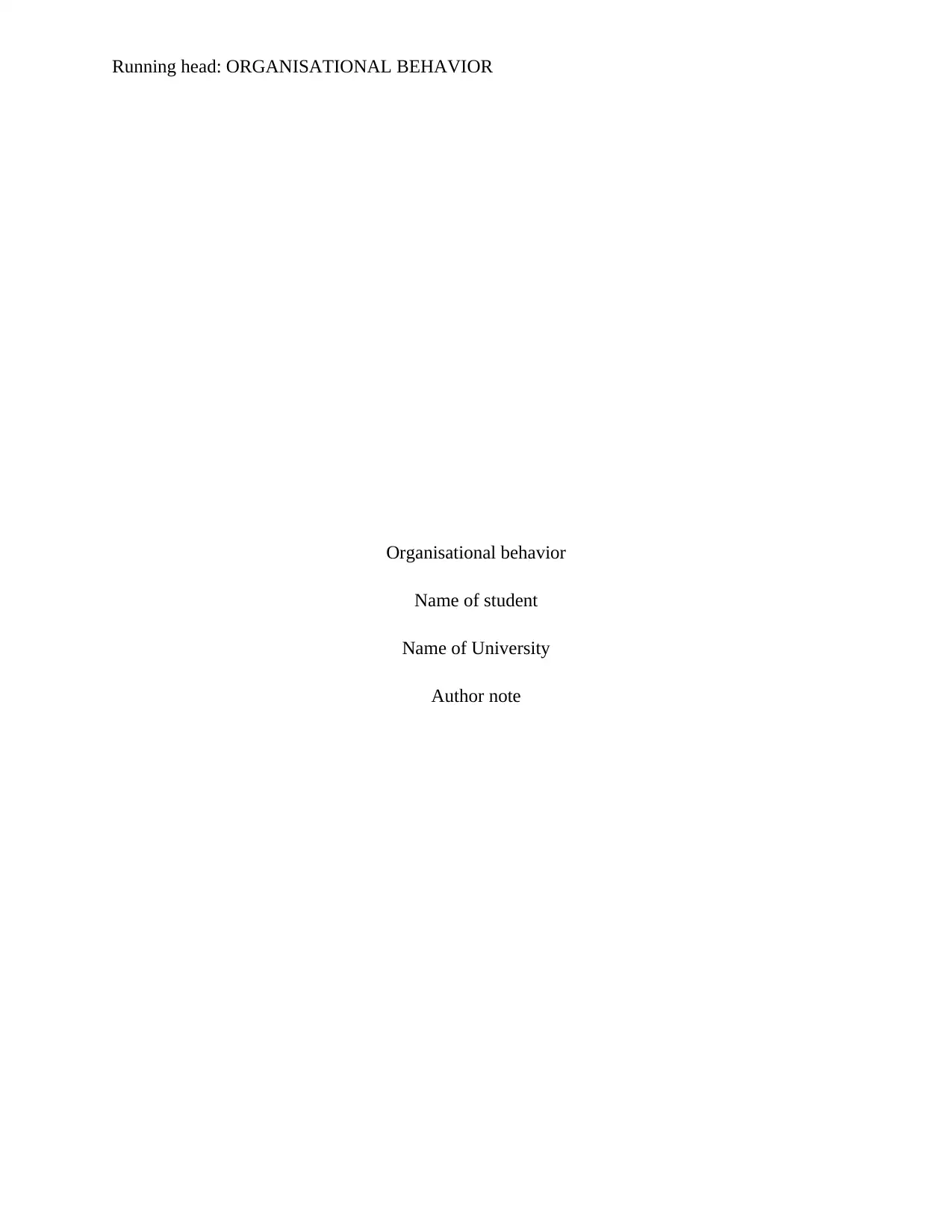
Running head: ORGANISATIONAL BEHAVIOR
Organisational behavior
Name of student
Name of University
Author note
Organisational behavior
Name of student
Name of University
Author note
Paraphrase This Document
Need a fresh take? Get an instant paraphrase of this document with our AI Paraphraser
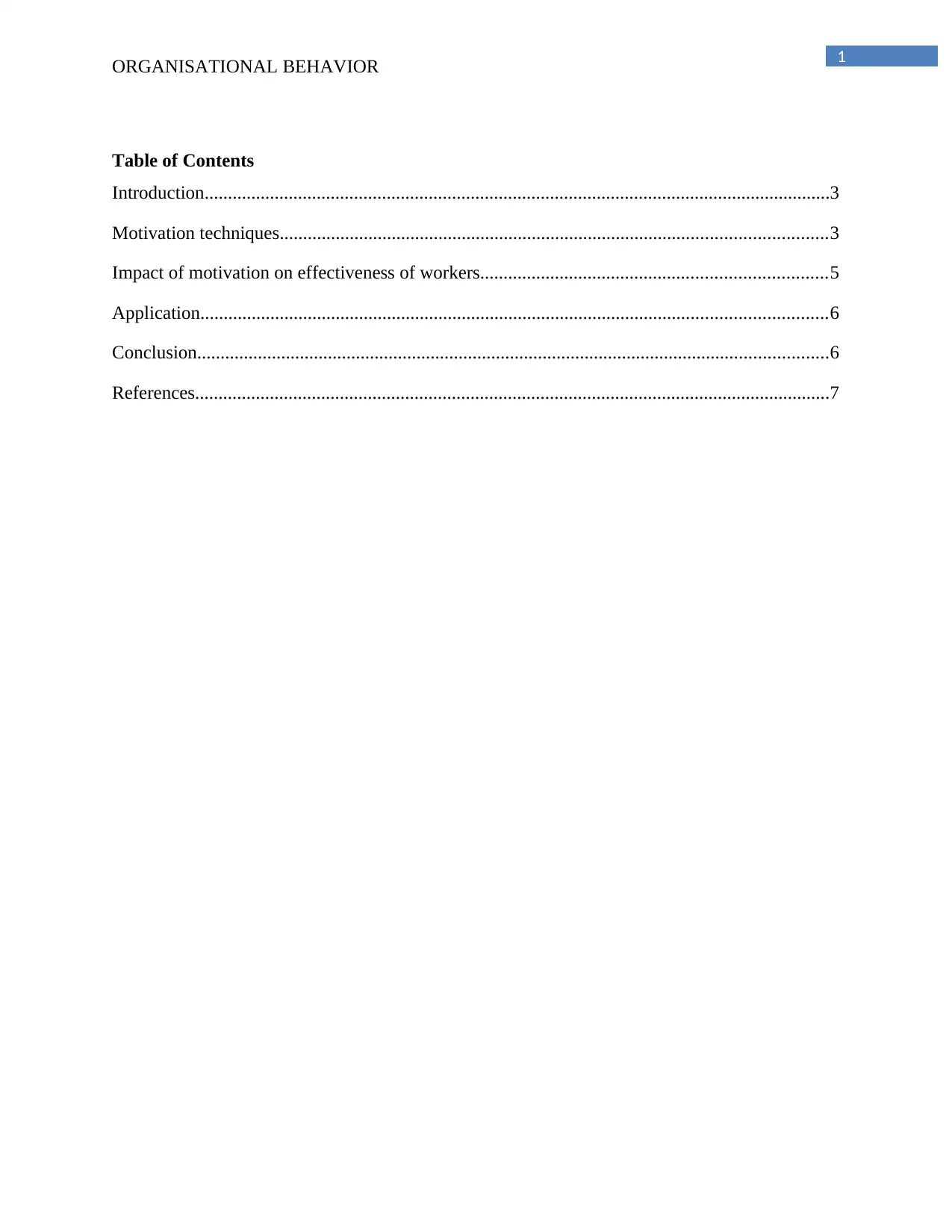
1
ORGANISATIONAL BEHAVIOR
Table of Contents
Introduction......................................................................................................................................3
Motivation techniques.....................................................................................................................3
Impact of motivation on effectiveness of workers..........................................................................5
Application......................................................................................................................................6
Conclusion.......................................................................................................................................6
References........................................................................................................................................7
ORGANISATIONAL BEHAVIOR
Table of Contents
Introduction......................................................................................................................................3
Motivation techniques.....................................................................................................................3
Impact of motivation on effectiveness of workers..........................................................................5
Application......................................................................................................................................6
Conclusion.......................................................................................................................................6
References........................................................................................................................................7
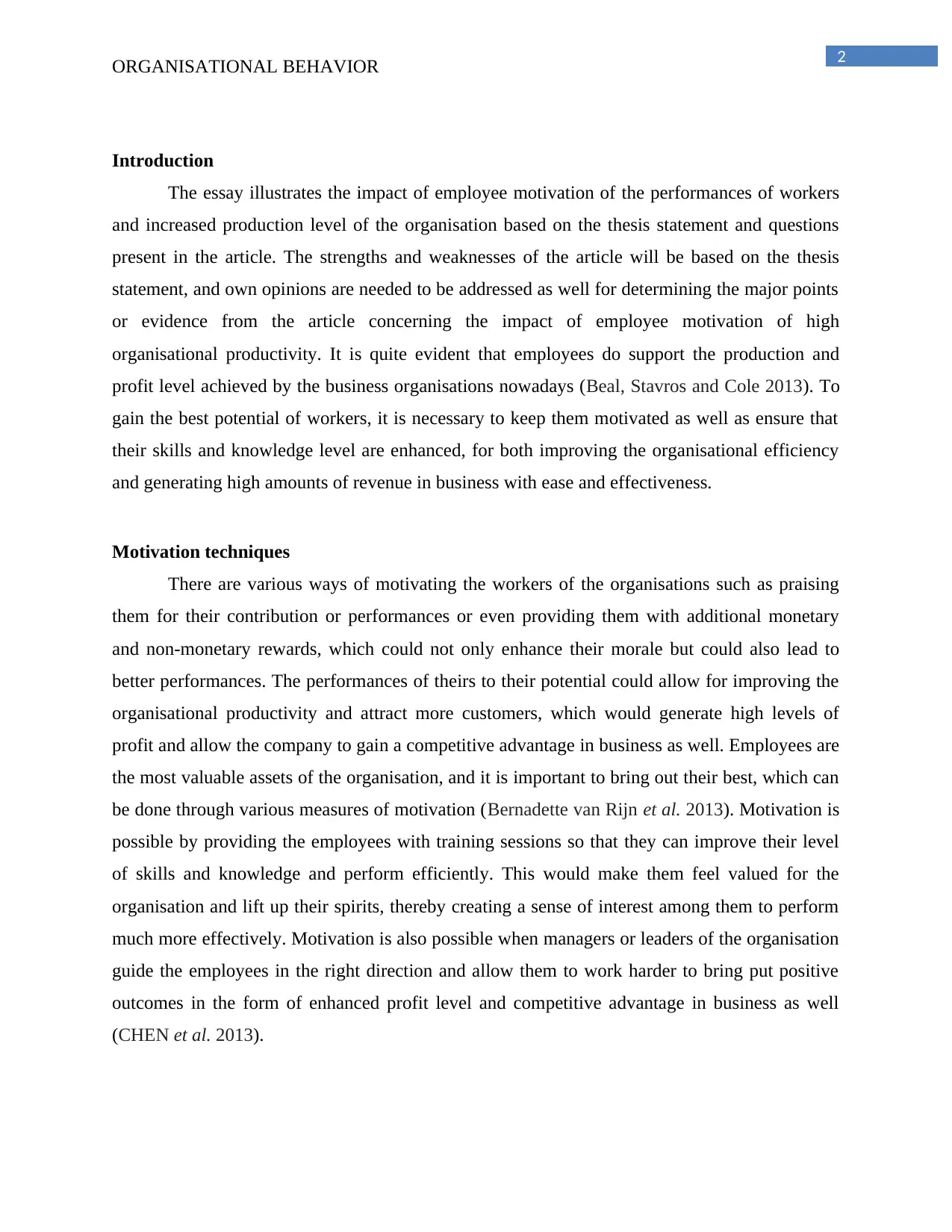
2
ORGANISATIONAL BEHAVIOR
Introduction
The essay illustrates the impact of employee motivation of the performances of workers
and increased production level of the organisation based on the thesis statement and questions
present in the article. The strengths and weaknesses of the article will be based on the thesis
statement, and own opinions are needed to be addressed as well for determining the major points
or evidence from the article concerning the impact of employee motivation of high
organisational productivity. It is quite evident that employees do support the production and
profit level achieved by the business organisations nowadays (Beal, Stavros and Cole 2013). To
gain the best potential of workers, it is necessary to keep them motivated as well as ensure that
their skills and knowledge level are enhanced, for both improving the organisational efficiency
and generating high amounts of revenue in business with ease and effectiveness.
Motivation techniques
There are various ways of motivating the workers of the organisations such as praising
them for their contribution or performances or even providing them with additional monetary
and non-monetary rewards, which could not only enhance their morale but could also lead to
better performances. The performances of theirs to their potential could allow for improving the
organisational productivity and attract more customers, which would generate high levels of
profit and allow the company to gain a competitive advantage in business as well. Employees are
the most valuable assets of the organisation, and it is important to bring out their best, which can
be done through various measures of motivation (Bernadette van Rijn et al. 2013). Motivation is
possible by providing the employees with training sessions so that they can improve their level
of skills and knowledge and perform efficiently. This would make them feel valued for the
organisation and lift up their spirits, thereby creating a sense of interest among them to perform
much more effectively. Motivation is also possible when managers or leaders of the organisation
guide the employees in the right direction and allow them to work harder to bring put positive
outcomes in the form of enhanced profit level and competitive advantage in business as well
(CHEN et al. 2013).
ORGANISATIONAL BEHAVIOR
Introduction
The essay illustrates the impact of employee motivation of the performances of workers
and increased production level of the organisation based on the thesis statement and questions
present in the article. The strengths and weaknesses of the article will be based on the thesis
statement, and own opinions are needed to be addressed as well for determining the major points
or evidence from the article concerning the impact of employee motivation of high
organisational productivity. It is quite evident that employees do support the production and
profit level achieved by the business organisations nowadays (Beal, Stavros and Cole 2013). To
gain the best potential of workers, it is necessary to keep them motivated as well as ensure that
their skills and knowledge level are enhanced, for both improving the organisational efficiency
and generating high amounts of revenue in business with ease and effectiveness.
Motivation techniques
There are various ways of motivating the workers of the organisations such as praising
them for their contribution or performances or even providing them with additional monetary
and non-monetary rewards, which could not only enhance their morale but could also lead to
better performances. The performances of theirs to their potential could allow for improving the
organisational productivity and attract more customers, which would generate high levels of
profit and allow the company to gain a competitive advantage in business as well. Employees are
the most valuable assets of the organisation, and it is important to bring out their best, which can
be done through various measures of motivation (Bernadette van Rijn et al. 2013). Motivation is
possible by providing the employees with training sessions so that they can improve their level
of skills and knowledge and perform efficiently. This would make them feel valued for the
organisation and lift up their spirits, thereby creating a sense of interest among them to perform
much more effectively. Motivation is also possible when managers or leaders of the organisation
guide the employees in the right direction and allow them to work harder to bring put positive
outcomes in the form of enhanced profit level and competitive advantage in business as well
(CHEN et al. 2013).
You're viewing a preview
Unlock full access by subscribing today!
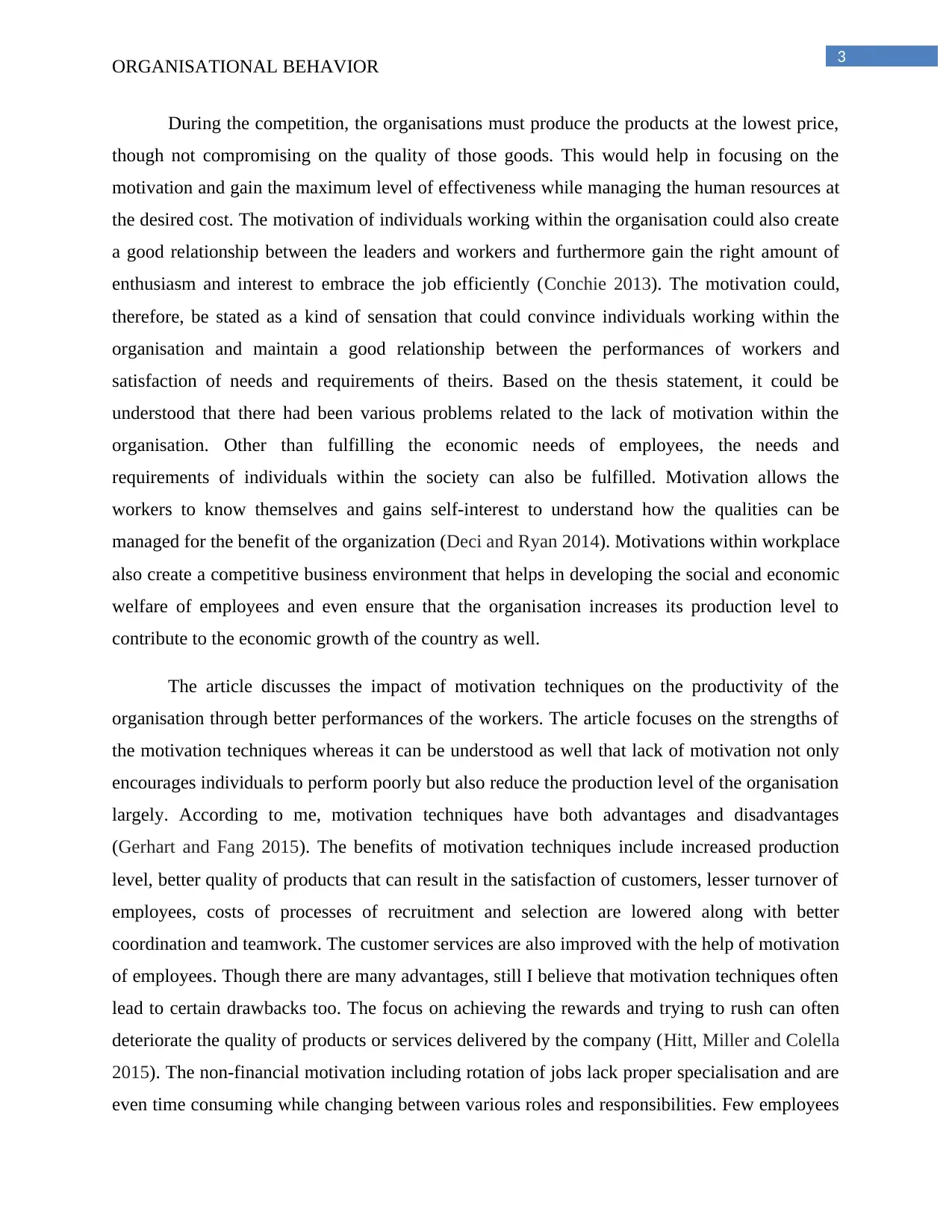
3
ORGANISATIONAL BEHAVIOR
During the competition, the organisations must produce the products at the lowest price,
though not compromising on the quality of those goods. This would help in focusing on the
motivation and gain the maximum level of effectiveness while managing the human resources at
the desired cost. The motivation of individuals working within the organisation could also create
a good relationship between the leaders and workers and furthermore gain the right amount of
enthusiasm and interest to embrace the job efficiently (Conchie 2013). The motivation could,
therefore, be stated as a kind of sensation that could convince individuals working within the
organisation and maintain a good relationship between the performances of workers and
satisfaction of needs and requirements of theirs. Based on the thesis statement, it could be
understood that there had been various problems related to the lack of motivation within the
organisation. Other than fulfilling the economic needs of employees, the needs and
requirements of individuals within the society can also be fulfilled. Motivation allows the
workers to know themselves and gains self-interest to understand how the qualities can be
managed for the benefit of the organization (Deci and Ryan 2014). Motivations within workplace
also create a competitive business environment that helps in developing the social and economic
welfare of employees and even ensure that the organisation increases its production level to
contribute to the economic growth of the country as well.
The article discusses the impact of motivation techniques on the productivity of the
organisation through better performances of the workers. The article focuses on the strengths of
the motivation techniques whereas it can be understood as well that lack of motivation not only
encourages individuals to perform poorly but also reduce the production level of the organisation
largely. According to me, motivation techniques have both advantages and disadvantages
(Gerhart and Fang 2015). The benefits of motivation techniques include increased production
level, better quality of products that can result in the satisfaction of customers, lesser turnover of
employees, costs of processes of recruitment and selection are lowered along with better
coordination and teamwork. The customer services are also improved with the help of motivation
of employees. Though there are many advantages, still I believe that motivation techniques often
lead to certain drawbacks too. The focus on achieving the rewards and trying to rush can often
deteriorate the quality of products or services delivered by the company (Hitt, Miller and Colella
2015). The non-financial motivation including rotation of jobs lack proper specialisation and are
even time consuming while changing between various roles and responsibilities. Few employees
ORGANISATIONAL BEHAVIOR
During the competition, the organisations must produce the products at the lowest price,
though not compromising on the quality of those goods. This would help in focusing on the
motivation and gain the maximum level of effectiveness while managing the human resources at
the desired cost. The motivation of individuals working within the organisation could also create
a good relationship between the leaders and workers and furthermore gain the right amount of
enthusiasm and interest to embrace the job efficiently (Conchie 2013). The motivation could,
therefore, be stated as a kind of sensation that could convince individuals working within the
organisation and maintain a good relationship between the performances of workers and
satisfaction of needs and requirements of theirs. Based on the thesis statement, it could be
understood that there had been various problems related to the lack of motivation within the
organisation. Other than fulfilling the economic needs of employees, the needs and
requirements of individuals within the society can also be fulfilled. Motivation allows the
workers to know themselves and gains self-interest to understand how the qualities can be
managed for the benefit of the organization (Deci and Ryan 2014). Motivations within workplace
also create a competitive business environment that helps in developing the social and economic
welfare of employees and even ensure that the organisation increases its production level to
contribute to the economic growth of the country as well.
The article discusses the impact of motivation techniques on the productivity of the
organisation through better performances of the workers. The article focuses on the strengths of
the motivation techniques whereas it can be understood as well that lack of motivation not only
encourages individuals to perform poorly but also reduce the production level of the organisation
largely. According to me, motivation techniques have both advantages and disadvantages
(Gerhart and Fang 2015). The benefits of motivation techniques include increased production
level, better quality of products that can result in the satisfaction of customers, lesser turnover of
employees, costs of processes of recruitment and selection are lowered along with better
coordination and teamwork. The customer services are also improved with the help of motivation
of employees. Though there are many advantages, still I believe that motivation techniques often
lead to certain drawbacks too. The focus on achieving the rewards and trying to rush can often
deteriorate the quality of products or services delivered by the company (Hitt, Miller and Colella
2015). The non-financial motivation including rotation of jobs lack proper specialisation and are
even time consuming while changing between various roles and responsibilities. Few employees
Paraphrase This Document
Need a fresh take? Get an instant paraphrase of this document with our AI Paraphraser
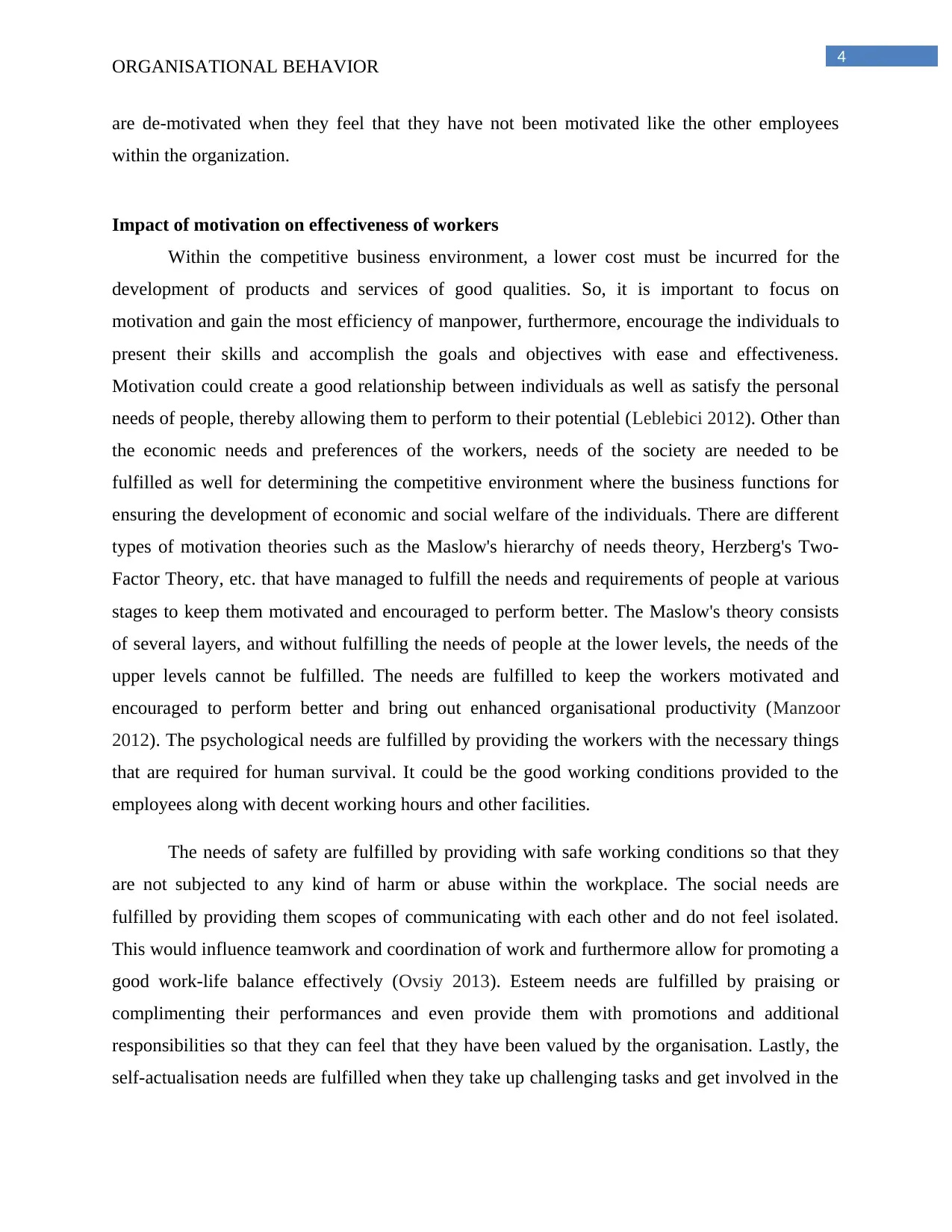
4
ORGANISATIONAL BEHAVIOR
are de-motivated when they feel that they have not been motivated like the other employees
within the organization.
Impact of motivation on effectiveness of workers
Within the competitive business environment, a lower cost must be incurred for the
development of products and services of good qualities. So, it is important to focus on
motivation and gain the most efficiency of manpower, furthermore, encourage the individuals to
present their skills and accomplish the goals and objectives with ease and effectiveness.
Motivation could create a good relationship between individuals as well as satisfy the personal
needs of people, thereby allowing them to perform to their potential (Leblebici 2012). Other than
the economic needs and preferences of the workers, needs of the society are needed to be
fulfilled as well for determining the competitive environment where the business functions for
ensuring the development of economic and social welfare of the individuals. There are different
types of motivation theories such as the Maslow's hierarchy of needs theory, Herzberg's Two-
Factor Theory, etc. that have managed to fulfill the needs and requirements of people at various
stages to keep them motivated and encouraged to perform better. The Maslow's theory consists
of several layers, and without fulfilling the needs of people at the lower levels, the needs of the
upper levels cannot be fulfilled. The needs are fulfilled to keep the workers motivated and
encouraged to perform better and bring out enhanced organisational productivity (Manzoor
2012). The psychological needs are fulfilled by providing the workers with the necessary things
that are required for human survival. It could be the good working conditions provided to the
employees along with decent working hours and other facilities.
The needs of safety are fulfilled by providing with safe working conditions so that they
are not subjected to any kind of harm or abuse within the workplace. The social needs are
fulfilled by providing them scopes of communicating with each other and do not feel isolated.
This would influence teamwork and coordination of work and furthermore allow for promoting a
good work-life balance effectively (Ovsiy 2013). Esteem needs are fulfilled by praising or
complimenting their performances and even provide them with promotions and additional
responsibilities so that they can feel that they have been valued by the organisation. Lastly, the
self-actualisation needs are fulfilled when they take up challenging tasks and get involved in the
ORGANISATIONAL BEHAVIOR
are de-motivated when they feel that they have not been motivated like the other employees
within the organization.
Impact of motivation on effectiveness of workers
Within the competitive business environment, a lower cost must be incurred for the
development of products and services of good qualities. So, it is important to focus on
motivation and gain the most efficiency of manpower, furthermore, encourage the individuals to
present their skills and accomplish the goals and objectives with ease and effectiveness.
Motivation could create a good relationship between individuals as well as satisfy the personal
needs of people, thereby allowing them to perform to their potential (Leblebici 2012). Other than
the economic needs and preferences of the workers, needs of the society are needed to be
fulfilled as well for determining the competitive environment where the business functions for
ensuring the development of economic and social welfare of the individuals. There are different
types of motivation theories such as the Maslow's hierarchy of needs theory, Herzberg's Two-
Factor Theory, etc. that have managed to fulfill the needs and requirements of people at various
stages to keep them motivated and encouraged to perform better. The Maslow's theory consists
of several layers, and without fulfilling the needs of people at the lower levels, the needs of the
upper levels cannot be fulfilled. The needs are fulfilled to keep the workers motivated and
encouraged to perform better and bring out enhanced organisational productivity (Manzoor
2012). The psychological needs are fulfilled by providing the workers with the necessary things
that are required for human survival. It could be the good working conditions provided to the
employees along with decent working hours and other facilities.
The needs of safety are fulfilled by providing with safe working conditions so that they
are not subjected to any kind of harm or abuse within the workplace. The social needs are
fulfilled by providing them scopes of communicating with each other and do not feel isolated.
This would influence teamwork and coordination of work and furthermore allow for promoting a
good work-life balance effectively (Ovsiy 2013). Esteem needs are fulfilled by praising or
complimenting their performances and even provide them with promotions and additional
responsibilities so that they can feel that they have been valued by the organisation. Lastly, the
self-actualisation needs are fulfilled when they take up challenging tasks and get involved in the
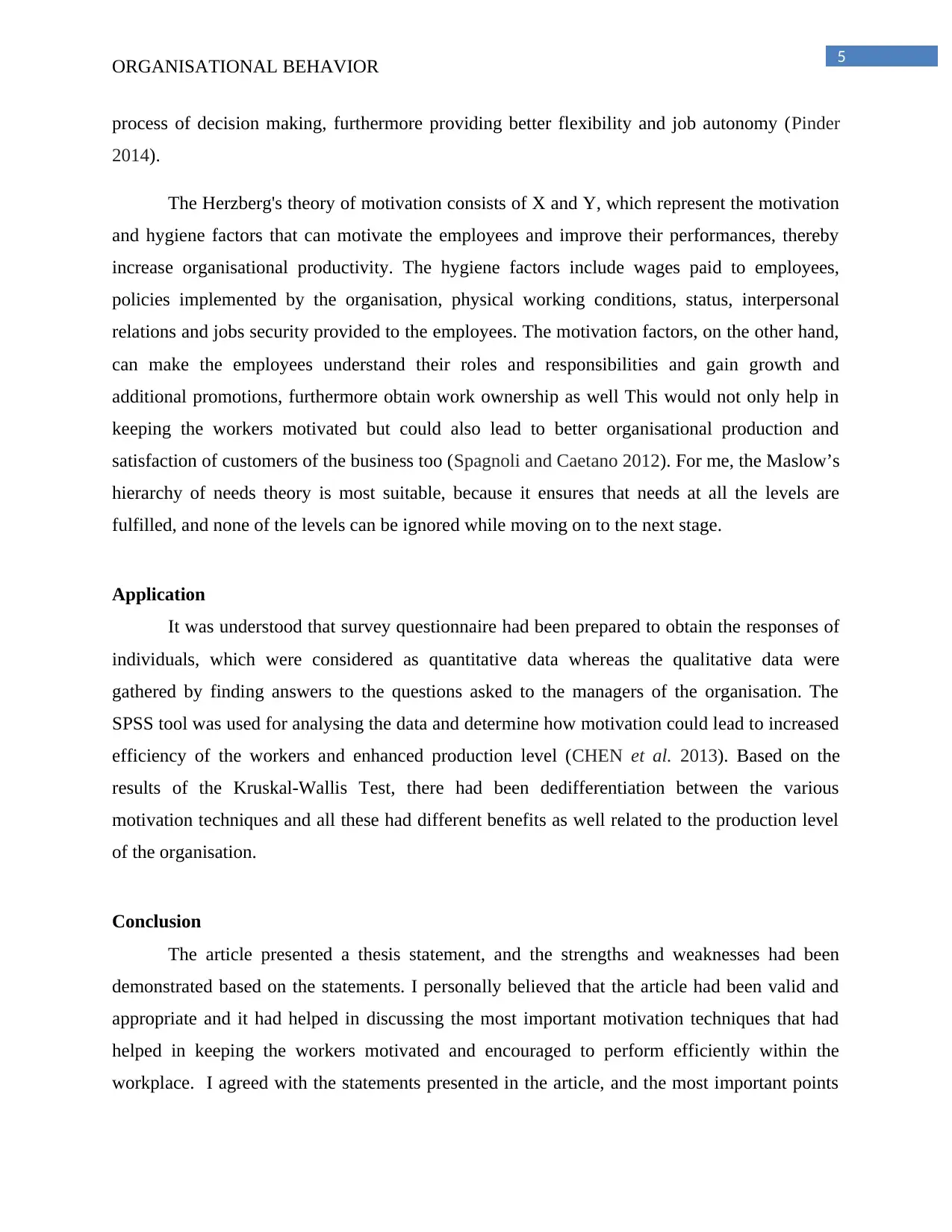
5
ORGANISATIONAL BEHAVIOR
process of decision making, furthermore providing better flexibility and job autonomy (Pinder
2014).
The Herzberg's theory of motivation consists of X and Y, which represent the motivation
and hygiene factors that can motivate the employees and improve their performances, thereby
increase organisational productivity. The hygiene factors include wages paid to employees,
policies implemented by the organisation, physical working conditions, status, interpersonal
relations and jobs security provided to the employees. The motivation factors, on the other hand,
can make the employees understand their roles and responsibilities and gain growth and
additional promotions, furthermore obtain work ownership as well This would not only help in
keeping the workers motivated but could also lead to better organisational production and
satisfaction of customers of the business too (Spagnoli and Caetano 2012). For me, the Maslow’s
hierarchy of needs theory is most suitable, because it ensures that needs at all the levels are
fulfilled, and none of the levels can be ignored while moving on to the next stage.
Application
It was understood that survey questionnaire had been prepared to obtain the responses of
individuals, which were considered as quantitative data whereas the qualitative data were
gathered by finding answers to the questions asked to the managers of the organisation. The
SPSS tool was used for analysing the data and determine how motivation could lead to increased
efficiency of the workers and enhanced production level (CHEN et al. 2013). Based on the
results of the Kruskal-Wallis Test, there had been dedifferentiation between the various
motivation techniques and all these had different benefits as well related to the production level
of the organisation.
Conclusion
The article presented a thesis statement, and the strengths and weaknesses had been
demonstrated based on the statements. I personally believed that the article had been valid and
appropriate and it had helped in discussing the most important motivation techniques that had
helped in keeping the workers motivated and encouraged to perform efficiently within the
workplace. I agreed with the statements presented in the article, and the most important points
ORGANISATIONAL BEHAVIOR
process of decision making, furthermore providing better flexibility and job autonomy (Pinder
2014).
The Herzberg's theory of motivation consists of X and Y, which represent the motivation
and hygiene factors that can motivate the employees and improve their performances, thereby
increase organisational productivity. The hygiene factors include wages paid to employees,
policies implemented by the organisation, physical working conditions, status, interpersonal
relations and jobs security provided to the employees. The motivation factors, on the other hand,
can make the employees understand their roles and responsibilities and gain growth and
additional promotions, furthermore obtain work ownership as well This would not only help in
keeping the workers motivated but could also lead to better organisational production and
satisfaction of customers of the business too (Spagnoli and Caetano 2012). For me, the Maslow’s
hierarchy of needs theory is most suitable, because it ensures that needs at all the levels are
fulfilled, and none of the levels can be ignored while moving on to the next stage.
Application
It was understood that survey questionnaire had been prepared to obtain the responses of
individuals, which were considered as quantitative data whereas the qualitative data were
gathered by finding answers to the questions asked to the managers of the organisation. The
SPSS tool was used for analysing the data and determine how motivation could lead to increased
efficiency of the workers and enhanced production level (CHEN et al. 2013). Based on the
results of the Kruskal-Wallis Test, there had been dedifferentiation between the various
motivation techniques and all these had different benefits as well related to the production level
of the organisation.
Conclusion
The article presented a thesis statement, and the strengths and weaknesses had been
demonstrated based on the statements. I personally believed that the article had been valid and
appropriate and it had helped in discussing the most important motivation techniques that had
helped in keeping the workers motivated and encouraged to perform efficiently within the
workplace. I agreed with the statements presented in the article, and the most important points
You're viewing a preview
Unlock full access by subscribing today!
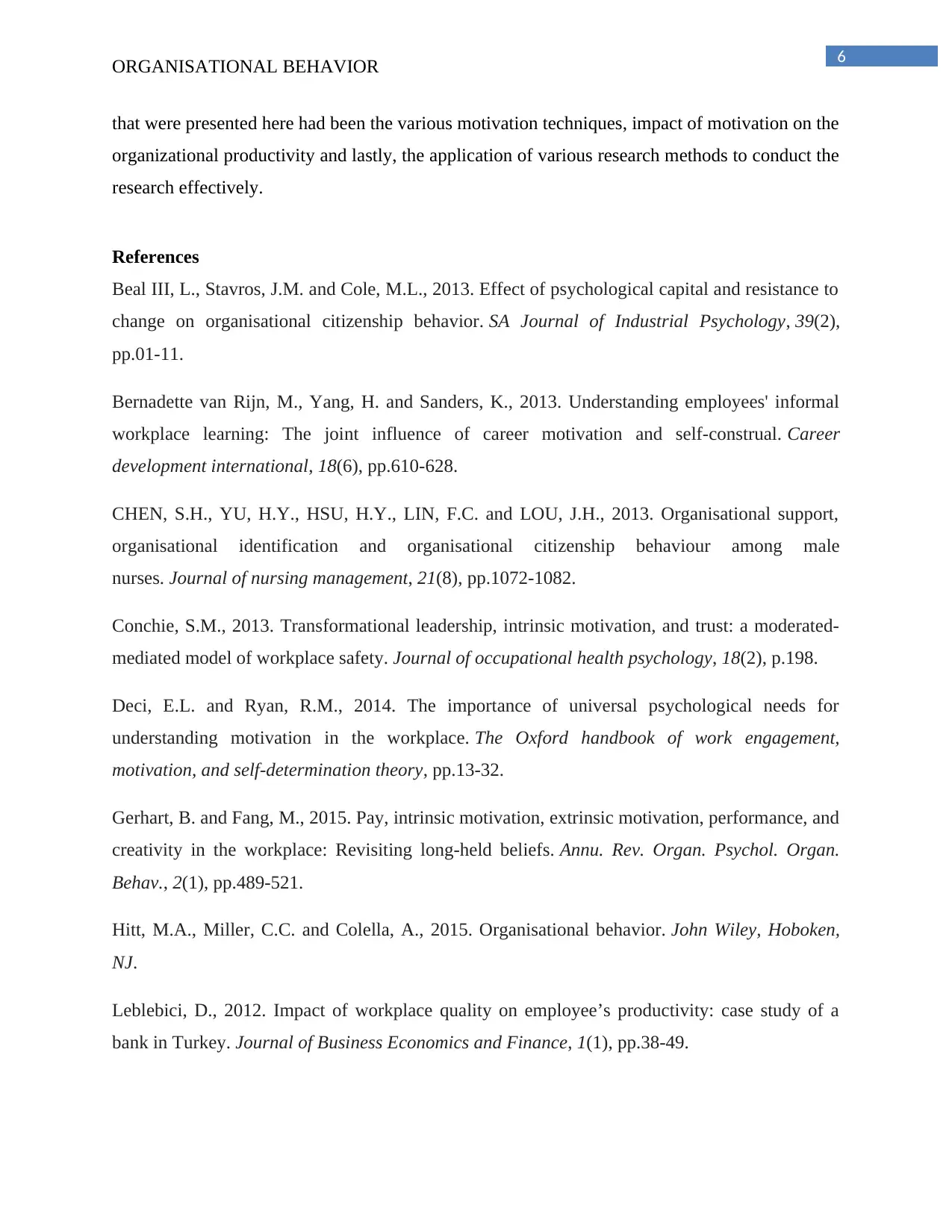
6
ORGANISATIONAL BEHAVIOR
that were presented here had been the various motivation techniques, impact of motivation on the
organizational productivity and lastly, the application of various research methods to conduct the
research effectively.
References
Beal III, L., Stavros, J.M. and Cole, M.L., 2013. Effect of psychological capital and resistance to
change on organisational citizenship behavior. SA Journal of Industrial Psychology, 39(2),
pp.01-11.
Bernadette van Rijn, M., Yang, H. and Sanders, K., 2013. Understanding employees' informal
workplace learning: The joint influence of career motivation and self-construal. Career
development international, 18(6), pp.610-628.
CHEN, S.H., YU, H.Y., HSU, H.Y., LIN, F.C. and LOU, J.H., 2013. Organisational support,
organisational identification and organisational citizenship behaviour among male
nurses. Journal of nursing management, 21(8), pp.1072-1082.
Conchie, S.M., 2013. Transformational leadership, intrinsic motivation, and trust: a moderated-
mediated model of workplace safety. Journal of occupational health psychology, 18(2), p.198.
Deci, E.L. and Ryan, R.M., 2014. The importance of universal psychological needs for
understanding motivation in the workplace. The Oxford handbook of work engagement,
motivation, and self-determination theory, pp.13-32.
Gerhart, B. and Fang, M., 2015. Pay, intrinsic motivation, extrinsic motivation, performance, and
creativity in the workplace: Revisiting long-held beliefs. Annu. Rev. Organ. Psychol. Organ.
Behav., 2(1), pp.489-521.
Hitt, M.A., Miller, C.C. and Colella, A., 2015. Organisational behavior. John Wiley, Hoboken,
NJ.
Leblebici, D., 2012. Impact of workplace quality on employee’s productivity: case study of a
bank in Turkey. Journal of Business Economics and Finance, 1(1), pp.38-49.
ORGANISATIONAL BEHAVIOR
that were presented here had been the various motivation techniques, impact of motivation on the
organizational productivity and lastly, the application of various research methods to conduct the
research effectively.
References
Beal III, L., Stavros, J.M. and Cole, M.L., 2013. Effect of psychological capital and resistance to
change on organisational citizenship behavior. SA Journal of Industrial Psychology, 39(2),
pp.01-11.
Bernadette van Rijn, M., Yang, H. and Sanders, K., 2013. Understanding employees' informal
workplace learning: The joint influence of career motivation and self-construal. Career
development international, 18(6), pp.610-628.
CHEN, S.H., YU, H.Y., HSU, H.Y., LIN, F.C. and LOU, J.H., 2013. Organisational support,
organisational identification and organisational citizenship behaviour among male
nurses. Journal of nursing management, 21(8), pp.1072-1082.
Conchie, S.M., 2013. Transformational leadership, intrinsic motivation, and trust: a moderated-
mediated model of workplace safety. Journal of occupational health psychology, 18(2), p.198.
Deci, E.L. and Ryan, R.M., 2014. The importance of universal psychological needs for
understanding motivation in the workplace. The Oxford handbook of work engagement,
motivation, and self-determination theory, pp.13-32.
Gerhart, B. and Fang, M., 2015. Pay, intrinsic motivation, extrinsic motivation, performance, and
creativity in the workplace: Revisiting long-held beliefs. Annu. Rev. Organ. Psychol. Organ.
Behav., 2(1), pp.489-521.
Hitt, M.A., Miller, C.C. and Colella, A., 2015. Organisational behavior. John Wiley, Hoboken,
NJ.
Leblebici, D., 2012. Impact of workplace quality on employee’s productivity: case study of a
bank in Turkey. Journal of Business Economics and Finance, 1(1), pp.38-49.
Paraphrase This Document
Need a fresh take? Get an instant paraphrase of this document with our AI Paraphraser
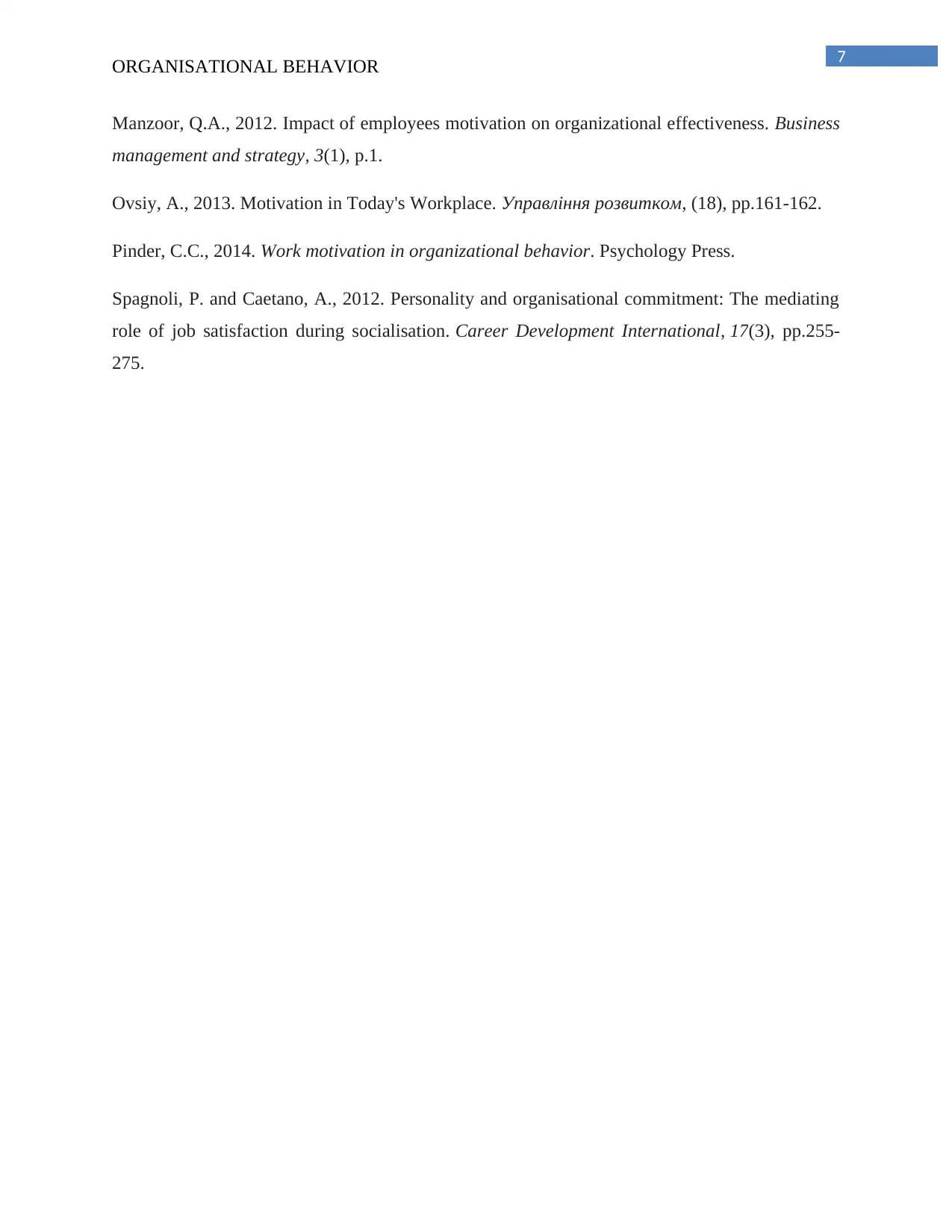
7
ORGANISATIONAL BEHAVIOR
Manzoor, Q.A., 2012. Impact of employees motivation on organizational effectiveness. Business
management and strategy, 3(1), p.1.
Ovsiy, A., 2013. Motivation in Today's Workplace. Управління розвитком, (18), pp.161-162.
Pinder, C.C., 2014. Work motivation in organizational behavior. Psychology Press.
Spagnoli, P. and Caetano, A., 2012. Personality and organisational commitment: The mediating
role of job satisfaction during socialisation. Career Development International, 17(3), pp.255-
275.
ORGANISATIONAL BEHAVIOR
Manzoor, Q.A., 2012. Impact of employees motivation on organizational effectiveness. Business
management and strategy, 3(1), p.1.
Ovsiy, A., 2013. Motivation in Today's Workplace. Управління розвитком, (18), pp.161-162.
Pinder, C.C., 2014. Work motivation in organizational behavior. Psychology Press.
Spagnoli, P. and Caetano, A., 2012. Personality and organisational commitment: The mediating
role of job satisfaction during socialisation. Career Development International, 17(3), pp.255-
275.
1 out of 8
Related Documents
Your All-in-One AI-Powered Toolkit for Academic Success.
+13062052269
info@desklib.com
Available 24*7 on WhatsApp / Email
![[object Object]](/_next/static/media/star-bottom.7253800d.svg)
Unlock your academic potential
© 2024 | Zucol Services PVT LTD | All rights reserved.





